Fisdap paramedic trauma - Study guides, Class notes & Summaries
Looking for the best study guides, study notes and summaries about Fisdap paramedic trauma? On this page you'll find 503 study documents about Fisdap paramedic trauma.
Page 3 out of 503 results
Sort by
PARAMEDIC TRAUMA FISDAP Exam 2023/2024 QUESTIONS AND ANSWERS GRADED A+
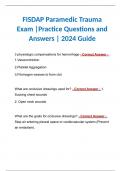
-
FISDAP Paramedic Trauma Exam |Practice Questions and Answers | 2024 Guide
- Exam (elaborations) • 16 pages • 2024
-
Available in package deal
-
- $10.49
- + learn more
FISDAP Paramedic Trauma Exam |Practice Questions and Answers | 2024 Guide FISDAP Paramedic Trauma Exam |Practice Questions and Answers | 2024 Guide FISDAP Paramedic Trauma Exam |Practice Questions and Answers | 2024 Guide
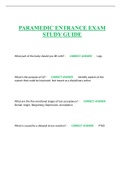
-
FISDAP Paramedic 2023/2024
- Package deal • 8 items • 2023
-
- $27.99
- 1x sold
- + learn more
1 Exam (elaborations) PARAMEDIC ENTRANCE EXAM STUDY GUIDE 2 Exam (elaborations) FISDAP AIRWAY EXAM 3 Exam (elaborations) PARAMEDIC FINAL REVIEW 4 Exam (elaborations) OB/PEDS PARAMEDIC FISDAP STUDY GUIDE 5 Exam (elaborations) PARAMEDIC TRAUMA FISDAP EXAM 6 Exam (elaborations) MEDICAL PARAMEDIC FISDAP 7 Exam (elaborations) PARAMEDIC FISDAP FINAL 200
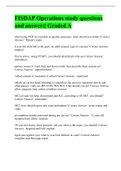
-
FISDAP Trauma, Medical, Airway, Cardiology, OBGYN, Operations Exam Practice Questions with Answers 2021/2022 | FINAL PARAMEDIC FISDAP COMPLETE STUDY GUIDE
- Package deal • 17 items • 2022
-
- $22.99
- 6x sold
- + learn more
FISDAP Trauma, Medical, Airway, Cardiology, OBGYN, Operations Exam Practice Questions with Answers 2021/2022 | FINAL PARAMEDIC FISDAP COMPLETE STUDY GUIDE
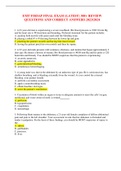
-
FISDAP Trauma, Medical, Airway, Cardiology, OBGYN, Operations Exam Practice Questions with Answers 2021/2022 | FINAL PARAMEDIC FISDAP COMPLETE STUDY GUIDE
- Package deal • 13 items • 2022
-
- $32.99
- 67x sold
- + learn more
FISDAP Trauma, Medical, Airway, Cardiology, OBGYN, Operations Exam Practice Questions with Answers 2021/2022 FINAL PARAMEDIC FISDAP COMPLETE STUDY GUIDE
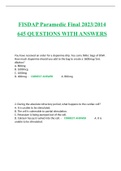
-
FISDAP Paramedic Final 2023/2014 645 QUESTIONS WITH ANSWERS
- Exam (elaborations) • 234 pages • 2023
- Available in package deal
-
- $12.49
- 1x sold
- + learn more
FISDAP Paramedic Final 2023/2014 645 QUESTIONS WITH ANSWERS You have received an order for a dopamine drip. You carry 500cc bags of D5W. How much dopamine should you add to the bag to create a 1600mcg/1mL dilution? A. 800mg B. 1600mcg C. 1600mg D. 400mcg - CORRECT ANSWER A. 800 mg 2. During the absolute refractory period, what happens to the cardiac cell? A. It is unable to be stimulated. B. The cell is vulnerable to partial stimulation. C. Potassiu...
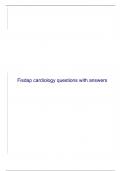
-
FISDAP Trauma, Medical, Airway, Cardiology, OBGYN, Operations Exam Practice Questions with Answers 2021/2022 | FINAL PARAMEDIC FISDAP COMPLETE STUDY GUIDE
- Package deal • 13 items • 2023
-
- $35.00
- 1x sold
- + learn more
1 Exam (elaborations) Fisdap cardiology questions with answers 2 Exam (elaborations) MEDICAL EMERGENCIES FISDAP QUESTIONS & ANSWERS 3rd test; REVISION GUIDE 2023 3 Exam (elaborations) Cardiology Fisdap Exam Questions and Answers 2023 Study Guide 4 Exam (elaborations) Trauma fisdap Questions and Answers 2023 5 SUMMARY Summary FINAL PARAMEDIC FIS
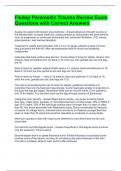
-
Fisdap Paramedic Trauma Review Exam Questions with Correct Answers
- Exam (elaborations) • 3 pages • 2024
- Available in package deal
-
- $9.49
- + learn more
Fisdap Paramedic Trauma Review Exam Questions with Correct Answers For thickness, or third-degree burns, or burns that extend through all layers of the skin and may involve subcutaneous tissue and muscle. The skin is dry, leathery, and often white orchard there's usually a little pain with these burns due to nerve endings being destroyed. Differentiate between types of shock - Answer-Cardiogenic shock: occurs when the heart cannot circulate enough blood to maintain adequate peripheral oxy...
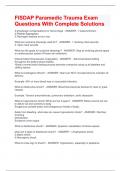
-
FISDAP Paramedic Trauma Exam Questions With Complete Solutions
- Exam (elaborations) • 6 pages • 2024
-
- $9.49
- + learn more
FISDAP Paramedic Trauma Exam Questions With Complete Solutions 3 physiologic compensations for hemorrhage - ANSWER- 1.Vasocontriction 2.Platelet Aggregation 3.Fibrinogen weaves to form clot What are occlusive dressings used for? - ANSWER- 1. Sucking chest wounds 2. Open neck wounds What are the goals for occlusive dressings? - ANSWER- Stop air entering pleural space or cardiovascular system (Prevent air embolism). Disseminated Intravascular Coagulation - ANSWER- - Abnormal blood c...
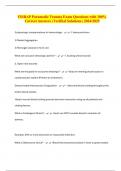
-
FISDAP Paramedic Trauma Exam Questions with 100% Correct Answers | Verified Solutions | 2024/2025
- Exam (elaborations) • 10 pages • 2024
-
- $9.99
- + learn more
FISDAP Paramedic Trauma Exam Questions with 100% Correct Answers | Verified Solutions | 2024/2025 3 physiologic compensations for hemorrhage - -1.Vasocontriction 2.Platelet Aggregation 3.Fibrinogen weaves to form clot What are occlusive dressings used for? - -1. Sucking chest wounds 2. Open neck wounds What are the goals for occlusive dressings? - -Stop air entering pleural space or cardiovascular system (Prevent air embolism). Disseminated Intravascular Coagulation - -- Abnormal blood ...

Do you wonder why so many students wear nice clothes, have money to spare and enjoy tons of free time? Well, they sell on Stuvia! Imagine your study notes being downloaded a dozen times for $15 each. Every. Single. Day. Discover all about earning on Stuvia



